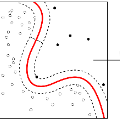Execution monitoring is essential for robots to detect and respond to failures. Since it is impossible to enumerate all failures for a given task, we learn from successful executions of the task to detect visual anomalies during runtime. Our method learns to predict the motions that occur during the nominal execution of a task, including camera and robot body motion. A probabilistic U-Net architecture is used to learn to predict optical flow, and the robot's kinematics and 3D model are used to model camera and body motion. The errors between the observed and predicted motion are used to calculate an anomaly score. We evaluate our method on a dataset of a robot placing a book on a shelf, which includes anomalies such as falling books, camera occlusions, and robot disturbances. We find that modeling camera and body motion, in addition to the learning-based optical flow prediction, results in an improvement of the area under the receiver operating characteristic curve from 0.752 to 0.804, and the area under the precision-recall curve from 0.467 to 0.549.
翻译:执行监测对于机器人检测和应对失败至关重要。 由于无法为某项任务列出所有失败, 我们从成功执行探测运行期间视觉异常的任务中学习。 我们的方法是预测在名义执行任务期间发生的动作, 包括相机和机器人身体运动。 一个概率性的 U- Net 结构用来学习预测光学流, 机器人的动脉学和 3D 模型用来模拟相机和身体运动。 观察到的和预测的动作之间的差错被用来计算异常分。 我们评估了我们在机器人在架子上放置书籍的数据集上的方法, 其中包括掉下来的书籍、 相机隔离和机器人扰动等异常现象。 我们发现, 除了基于学习的光流预测外, 模拟相机和身体运动的结果是, 接收器操作特征曲线下的区域从0.752 7 到 0. 804, 以及精确召回曲线下的区域从 0. 467 到 0 549 。





